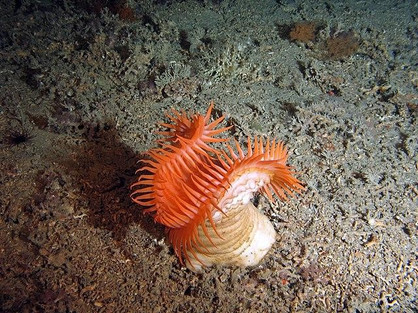We know more about the surface of Mars than we do about our ocean. Grace Smith-Beacham reports on the devastation that deep sea mining could cause if greenlighted by policymakers.
It’s true that only 0.05% of the ocean has been accurately mapped, compared to 100% of Mars being mapped in detail. This is due to the cold temperatures, immense pressure and lack of significant light in the ocean beyond 200 metres, making it near to impossible for humans to explore. The hadal zone (named after Hades, the Greek god of the underworld) is the deepest marine habitat on Earth, extending 11km below the surface of the world’s oceans, with very few vehicles capable of plunging into this dark abyss. However, with NASA building the latest autonomous underwater vehicles, the most inaccessible place on Earth (for us!) is becoming more accessible, and with it comes a thirst for knowledge, exploration and for some, exploitation.
Left - Deep sea corals at the Wagner Seamount. Image Credit: Wikimedia Commons. Right - Venus flytrap sea anemone off the coast of Ireland at 780m deep. Image Credit: Marum on Wikimedia Commons.
Deep sea mining is a potential commercial industry, attempting to mine deposits on the seafloor (including abyssal plains, seamounts and hydrothermal vents). The industry aims to extract valuable minerals (such as manganese, copper, cobalt, zinc and rare earth metals), potentially helping to meet demand for those minerals crucial for the development of green energy and technological advancements.
The deep sea contains three primary sources for mining these critical minerals: potato sized manganese nodules (polymetallic nodules), deposits of sulphur-containing minerals around hydrothermal vents, and cobalt-rich crusts that line the sides of mid-ocean ridges and seamounts. Mining the deep sea will rely on remotely-operated extraction devices to dredge the ocean floor or seamount crust, attached to huge hydraulic lifting systems to carry the extracted material to surface ships or floating platforms. Noise and light from mining would create sound and light pollution, as well as stirring up sediment plumes laced with metals, negatively impacting unique marine species as well as dredging their delicate habitats. Ultimately, resulting in ecosystem destruction.

Schematic diagram of deep sea mining. Image Credit: G. Mannaerts on Wikimedia Commons.

8-9mm thick deep seafloor manganese nodule. Image Credit: James St. John Wikimedia Commons.
So much is left unknown about the deep sea, and to destroy the habitats of species we know so little about would be devastating. While polymetallic nodules are estimated to contain more cobalt and nickel than all known land deposits, mining them is predicted to cause irreversible damage to the habitats known for sponges, polychaete, worms, corals and other deep sea creatures.
Researchers have predicted that the repercussions of deep sea mining will ‘impair processes associated with feeding, growth and reproduction, which can ultimately lead to smaller standing stocks, altered communities and loss of biodiversity’ in both benthic (seafloor) ecosystems and pelagic (open sea) ecosystems. This demonstrates the immense impacts that deep sea mining presents to different ecosystems, not just the ones directly mined.
While the impacts of deep sea mining on biodiversity will be devastating, it is not the only problem. Benthic ecosystems are known for their long-term carbon storage abilities, due to the sinking of organic matter which is later stored in the sediments that if dredged, will release the stored carbon. Undoubtedly, more research is required to determine the mechanisms of nutrient cycling in benthic ecosystems, requiring time - not the authorisation of deep sea mining.

Image of typical benthic species. Image Credit: G. Carter on Wikimedia Commons.
On 22nd July 2023, council members of the International Seabed Authority (ISA) met in Kingston, Jamaica to discuss the future of mining seabeds in international waters. There have always been uncertainties surrounding operating in international waters and the mining industry is no exception. The negotiations aimed to create a set of laws governing seabed mining by July 2025, with companies being allowed to submit applications in the meantime.
Well-known director and ocean explorer James Cameron has recently expressed support for the problematic deep sea mining process, claiming it is less harmful than mining on land. This could seem plausible due to the controversial and destructive practices of mining the land, traced back to the earliest known coal mine estimated to be from 20,000 to 40,000 years ago. Effects from land-based mining include runoff of toxic wastewater, deforestation and soil contamination, as well as the use of child labour now and throughout history.
While it is reported that just 7% of deforestation has been directly driven by mining, it is increasingly being understood that mining has had significant indirect and cumulative impacts, with it suggested that between 10% and up to one third of the world's forests are being affected by mining. This links the land mining industry to thousands of large-scale mines in forests, contributing to large scale habitat loss, land degradation and pollution.






Comments